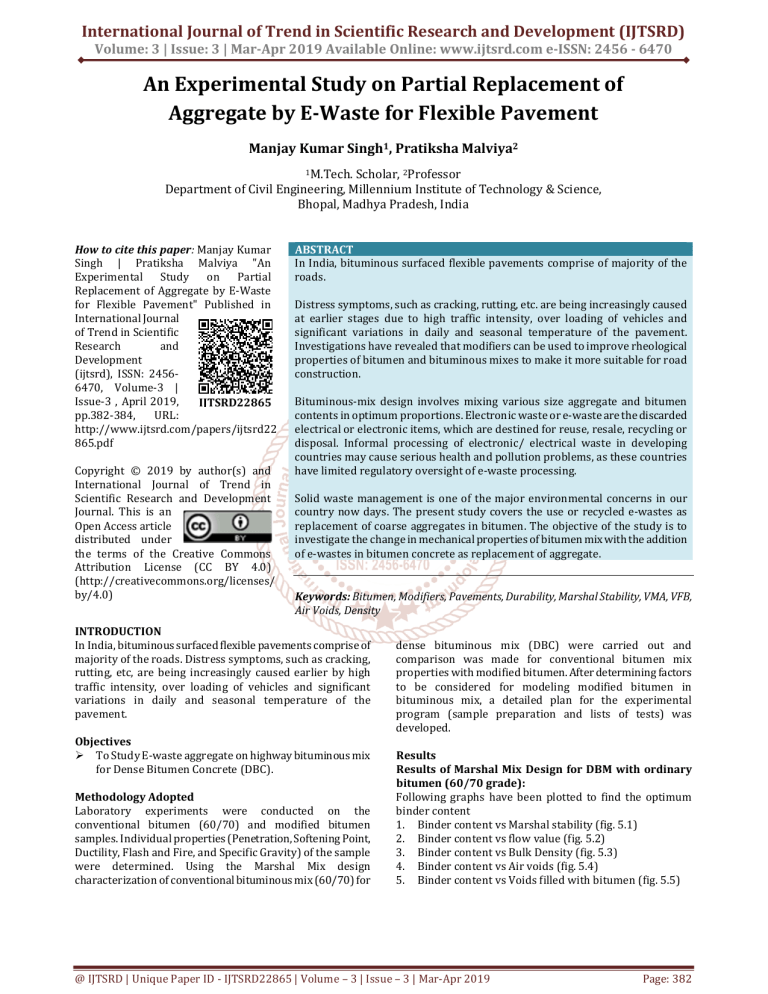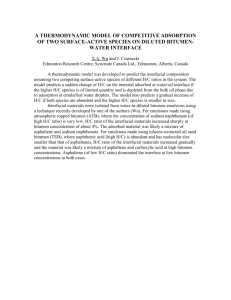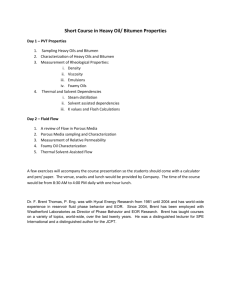
International Journal of Trend in Scientific Research and Development (IJTSRD)
Volume: 3 | Issue: 3 | Mar-Apr 2019 Available Online: www.ijtsrd.com e-ISSN: 2456 - 6470
An Experimental Study on Partial Replacement of
Aggregate by E-Waste for Flexible Pavement
Manjay Kumar Singh1, Pratiksha Malviya2
1M.Tech.
Scholar, 2Professor
Department of Civil Engineering, Millennium Institute of Technology & Science,
Bhopal, Madhya Pradesh, India
How to cite this paper: Manjay Kumar
Singh | Pratiksha Malviya "An
Experimental Study on
Partial
Replacement of Aggregate by E-Waste
for Flexible Pavement" Published in
International Journal
of Trend in Scientific
Research
and
Development
(ijtsrd), ISSN: 24566470, Volume-3 |
Issue-3 , April 2019,
IJTSRD22865
pp.382-384,
URL:
http://www.ijtsrd.com/papers/ijtsrd22
865.pdf
Copyright © 2019 by author(s) and
International Journal of Trend in
Scientific Research and Development
Journal. This is an
Open Access article
distributed under
the terms of the Creative Commons
Attribution License (CC BY 4.0)
(http://creativecommons.org/licenses/
by/4.0)
ABSTRACT
In India, bituminous surfaced flexible pavements comprise of majority of the
roads.
Distress symptoms, such as cracking, rutting, etc. are being increasingly caused
at earlier stages due to high traffic intensity, over loading of vehicles and
significant variations in daily and seasonal temperature of the pavement.
Investigations have revealed that modifiers can be used to improve rheological
properties of bitumen and bituminous mixes to make it more suitable for road
construction.
Bituminous-mix design involves mixing various size aggregate and bitumen
contents in optimum proportions. Electronic waste or e-waste are the discarded
electrical or electronic items, which are destined for reuse, resale, recycling or
disposal. Informal processing of electronic/ electrical waste in developing
countries may cause serious health and pollution problems, as these countries
have limited regulatory oversight of e-waste processing.
Solid waste management is one of the major environmental concerns in our
country now days. The present study covers the use or recycled e-wastes as
replacement of coarse aggregates in bitumen. The objective of the study is to
investigate the change in mechanical properties of bitumen mix with the addition
of e-wastes in bitumen concrete as replacement of aggregate.
Keywords: Bitumen, Modifiers, Pavements, Durability, Marshal Stability, VMA, VFB,
Air Voids, Density
INTRODUCTION
In India, bituminous surfaced flexible pavements comprise of
majority of the roads. Distress symptoms, such as cracking,
rutting, etc, are being increasingly caused earlier by high
traffic intensity, over loading of vehicles and significant
variations in daily and seasonal temperature of the
pavement.
Objectives
To Study E-waste aggregate on highway bituminous mix
for Dense Bitumen Concrete (DBC).
Methodology Adopted
Laboratory experiments were conducted on the
conventional bitumen (60/70) and modified bitumen
samples. Individual properties (Penetration, Softening Point,
Ductility, Flash and Fire, and Specific Gravity) of the sample
were determined. Using the Marshal Mix design
characterization of conventional bituminous mix (60/70) for
dense bituminous mix (DBC) were carried out and
comparison was made for conventional bitumen mix
properties with modified bitumen. After determining factors
to be considered for modeling modified bitumen in
bituminous mix, a detailed plan for the experimental
program (sample preparation and lists of tests) was
developed.
Results
Results of Marshal Mix Design for DBM with ordinary
bitumen (60/70 grade):
Following graphs have been plotted to find the optimum
binder content
1. Binder content vs Marshal stability (fig. 5.1)
2. Binder content vs flow value (fig. 5.2)
3. Binder content vs Bulk Density (fig. 5.3)
4. Binder content vs Air voids (fig. 5.4)
5. Binder content vs Voids filled with bitumen (fig. 5.5)
@ IJTSRD | Unique Paper ID - IJTSRD22865 | Volume – 3 | Issue – 3 | Mar-Apr 2019
Page: 382
International Journal of Trend in Scientific Research and Development (IJTSRD) @ www.ijtsrd.com eISSN: 2456-6470
5.3.2: Results of DBM with E-Waste
By using this optimum binder content (i.e. 5.5%) various
samples of varying E-Waste Fiber percentages (4%, 8%,
10%, 12%) were prepared and subsequent tests have been
performed, to find properties of modified DBM. The table
(5.9) shows the various properties E-Waste modified DBM
mix.
Figure 5.1 Bitumen % Vs Marshal Stability Value
The results shows that Marshal Stability increases with the
increase of E-Waste Fiber percentage from 6% to 10% but it
decreases at higher percentage (i.e. 12%). Also the flow
value, Bulk Density, VMA and VFB increases with increase of
E-Waste Fiber.
Since DBM shows better properties with 10% E-Waste Fiber
Modified Bitumen, the test were performed to find the
optimum binder content by fixing the percent of E-Waste
Fiber i.e. 10%. Various properties of the mix are shown
below in the table.
Figure 5.2 Bitumen % Vs Flow value
Following graphs have been plotted to find the optimum
binder content with 10% E-Waste
1. Binder content vs Marshal stability (fig. 5.6)
2. Binder content vs flow value (fig. 5.7)
3. Binder content vs Density (fig. 5.8)
4. Binder content vs Air voids (fig. 5.9)
5. Binder content vs Voids filled with bitumen (fig. 5.10)
It is observed from graphs, that maximum marshal value is
obtained with 5.25% modified bitumen compared 5.5%
ordinary bitumen in DBM.
It is therefore inferred that 10% E-WASTE admixture saves
bitumen content, without adversely affecting Marshal
Stability Value.
Figure 5.3 Bitumen % Vs Density
Figure 5.4 Bitumen % Vs Air voids %
Figure 5.6 Bitumen % Vs Marshal Stability Value (with
10% E-WASTE)
Figure 5.5 Bitumen % Vs Voids filled with
bitumen %( VFB)
Figure 5.7 Bitumen % Vs Flow value (with 10% E-WASTE)
@ IJTSRD | Unique Paper ID - IJTSRD22865 | Volume – 3 | Issue – 3 | Mar-Apr 2019
Page: 383
International Journal of Trend in Scientific Research and Development (IJTSRD) @ www.ijtsrd.com eISSN: 2456-6470
REFERENCES
[1] Maharashtra pollution control board (2007),”Report on
Assessment of Electronic Waste in Mumbai- pune area”
south Asia publishing Pvt. Ltd. New Delhi. Chapter 1(312), 6(55-56).
[2]
Manual for Construction and Supervision of
Bituminous works publish by Indian Roads Congress
for Department of Road Transport & Highways,
Ministry of Shipping, Road Transport & Highways New
Delhi 2001.
[3]
“Ministry of road transport and highway (2001)”,
Indian Roads Congress, New Delhi; 2001.
[4]
Neutag L University Wuppertal, Pavement Research
Centre Wuppertal, Germany 2009.
[5]
R. Vasudevan, S. K. Nigam, R. Velkennedy, A.
Ramalingam
Chandranan
sekar
&
B.
Sunderakannan(2007), “Utilization of waste polymer
for flexible pavement and easy disposal of waste
polymers", Proceedings of the international conference
on sustainable solid waste management, CPCB, New
Delhi.
[6]
Sabina, Khan Tabrez A, Sangita, Sharma D.K., Sharma
B.M, Performance Evalution. Of Waste Plastic/
Polymers Modified Bituminious Concrete Mixes,
Journal of Scientific and Industrial Research Vol.68,
November 2009.
[7]
Shankar S., Prasad C.S.R.K., September2009, Evaluation
of rutting potential for crumb rubber modified bitumen
in asphaltic mixes. Emirates Journal for Engineering
Research, 14 (2), pp- 91-95 2009.
[8]
Shrivastava Anil, Polymer Modified Bitumen and
Related Properties, Indian Road Congress Seminar on
Bituminous Roads: Design and Construction Aspects
1994.
[9]
T. Awwad Mohammad and Shbeeb Lina the Use of
Polyethylene in Hot Asphalt Mixtures, American
Journal of Applied Sciences 4 (6): pp-390-396, 2007.
Figure 5.8 Bitumen % Vs Density (with 10% E-WASTE)
Figure 5.9 Bitumen % Vs Air voids %
(with 10% E-WASTE)
Figure 5.10 Bitumen % Vs Voids filled with
bitumen %( VFB) (with 10% E-WASTE)
CONCLUSION
It has been observed when the E-WASTE is mixed with
bitumen with varying % (4, 8, 10, and 12) properties of
bitumen like penetration value, ductility, flash and fire point,
specific gravity and softening point change. As discussed
earlier in chapter 5 it is observed experimentally that the
penetration, ductility decreased and softening point and
specific gravity values are increased as the % of E-WASTE
increases. While in the case of flash and fire point values first
increases (with 4, 8 and 10%) and then decreases at 12% of
E-WASTE. significant change in properties of DBM was
observed as per follows.
FUTURE SCOPE OF WORK
In future, the similar study can be done on different
grade of Bitumen Mix.
In future, the similar study can be done on Semi Dense
Bituminous Mix (SDBM) to get enhanced properties.
[10] Vasudevan R., Nigam S.K., Velkennedy R., Ramalinga
Chandra Sekar A., Sundarakannan B. Utilization of
Waste Polymers for Flexible Pavement and Easy
Disposal of Waste Polymers, International Conference
on Sustainable Solid Waste Management, 5 - 7, Chennai,
India. Pp-105-111 September 2014.
[11] Vasudevan R., Rajasekaran S., Study of the construction
of flexible road using plastic coated aggregate 2015.
[12] Vasudevan, R., Utilization of waste plastics for flexible
pavement, Indian High Ways Indian Road Congress,
Vol. 34, No.7 July 2006.
[13] Yadav Kajal, Sangita and Chandra A, Identification,
Characterization
and
Quantification
of
Elastomeric/Plastomeric Waste for Sustainable Waste
Minimization American Journal of Environmental
Sciences 1 (3): pp-202-205, 2015.
@ IJTSRD | Unique Paper ID - IJTSRD22865 | Volume – 3 | Issue – 3 | Mar-Apr 2019
Page: 384


